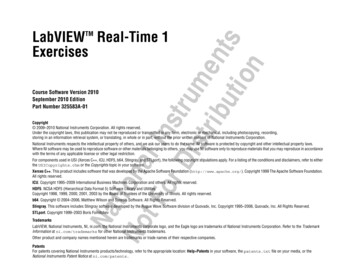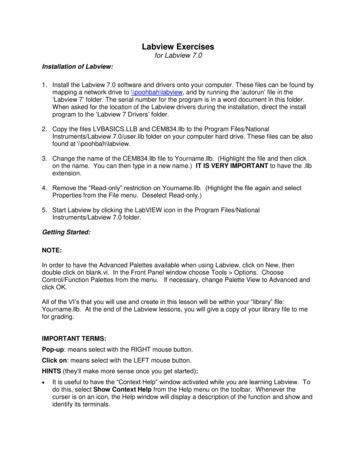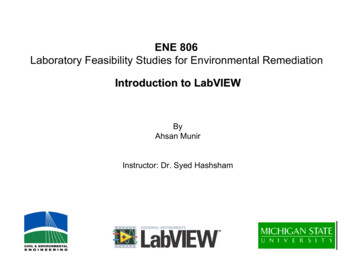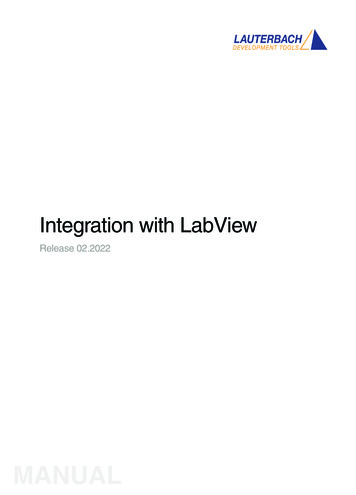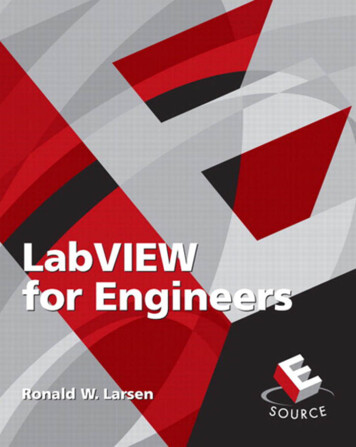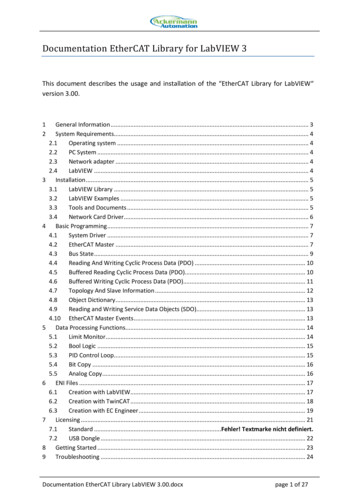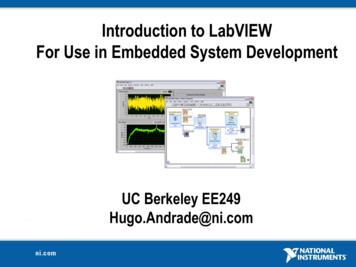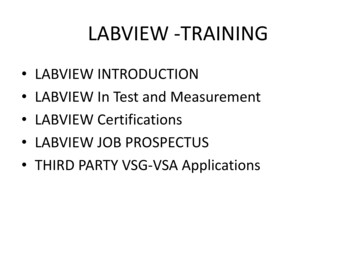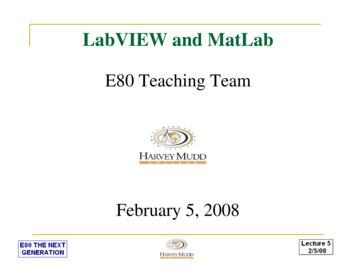
Transcription
LabVIEW and MatLabE80 Teaching TeamFebruary 5, 2008
LabVIEW and MATLABMATLABObjectives of this lecture Learn LabVIEW and LabVIEW’s functions Understand, design, modify and use VirtualInstruments (VIs) Construct (modify) and use data acquisitionapplications for acquiring and processing digital andanalog signals supplied by sensors, transmitters,
Outline Basics of LabVIEW Mathscript and LabVIEW Data Acquisition with LabVIEW MATLAB
What is LabVIEW?Laboratory Virtual Instrument Engineering WorkbenchA Graphical Program Development EnvironmentUsed in some of the most advanced R&D labs (JPL, Siemens Medical, )Has been around since 1980The best way to learn LabVIEW is to PRACTICE, PRACTICE, PRACTICEHighly Addictive!
What is the use of LabVIEW in E80?We will use LabVIEW to . Monitor and connect to sensors and measurement devices in an experiment Retrieve signals using data acquisition platforms controlled by LabVIEW Process data and represent them in a meaningful, efficient way Consolidate all the data obtained in the experiment to perform analysisVideo: LabVIEW and Rubik Cube!
Where can I find LabVIEW? Your E80 laptops will have LabVIEW 8.2.1 installed on them You can install LabVIEW on your PC using the CD thatcomes with your you textbook There are lots of information about LabVIEW that you canfind on the web and on National Instrument’s web page:www.ni.com/labview/
The very first step ?31This is what you seeif you run LabVIEWOn your PC2
BasicsLabVIEW programs are called Virtual Instruments (VIs)Front PanelControls InputsIndicators OutputsTip:Every LabVIEW vihas a Front Panel anda Block DiagramBlock DiagramBehind the sceneComponents wired
The Front Panel
The Block diagramTip: Use Ctrl-E to switch between front panel and block diagram
Basic Functions
Tools PaletteActivatingTools Palette
VIs and Functions
Example 1 : Simple ConversionR V VrefV RrefGoal: Convert voltage to resistance1)Have an input signal in voltscoming from a thermistor2)Know the conversion equationbetween the voltage receivedand the resistance desired3)Need an interactive vi to showus the resistance for input valueof voltageInput and Refs.Display
Example 1 : Simple ConversionR Goal: Convert voltage to resistance1)Have an input signal in voltscoming from a thermistor2)Know the conversion equationfor the voltage read, andresistance3)Need an interactive vi to showus the resistance for input valueof voltageInput and Refs.OperationsOutputTip: Use Ctrl-E to switch between front panel and block diagramV VrefV Rref
Demonstration I
Example 2 : Thermistor CalculationGoal: Calculate temperature frommeasured resistance 1)Know the conversion equationfor the resistance read2)Have constants in the equation3)Calculate temperature in C4)Convert temperature to KInputConstantsResults
Example 2 : Thermistor CalculationTo KK13A B ln(R ) C [ln (R )]T o T o 273.15CInputConstantsUnbundled (see Ch. 7)Mathscript ( similar to MATLAB)
Demonstration II
Example 3 : Function GeneratorGoal: Make a function generatorthat 1)Allows choosing signal type,varying frequency, amplitude,offset, phase, 2)Displays the signal graphically3)Addresses sampling rate andtracking of the signalControlsControlsDisplay
Example 3: Function GeneratorMethod:Use available modules as “buildingblocks” and “wires” as connectiontools for flow of data/commands to Tie elements to each other in aninteractive, repetitive platform.Numerical DataWhile Loop (Ch. 6)Function Generator VI(Express)Tip: Use Ctrl-H and point on a component for a pop-up help windowDisplay
Example 3: Function Generator
Example 3: Numeric Data Types
Demonstration III
LabVIEW Mathscript A LabVIEW tool for executing textual mathematical commands Matrix and vector based calculations (linear algebra)Visualization of data in plotsRunning scripts containing a number of commands written in a fileA large number of mathematical functions. An overview is given laterin this document.MathScript command are equal to MATLAB commands (someMATLAB commands may not be implemented).
LabVIEW Mathscript
How do I use Mathscript? MathScript can be used in two ways In a MathScript window as a desktop mathematical tool independent ofLabVIEW In a MathScript node which appears as a frame inside the Blockdiagram of a VI (available on the Functions / Mathematics / Scripts &Formulas palette.)
Example 4: Plotting a sine waveRunPlott [0:.1:100]';Scx -1 0.02*t;ripty sin(0.2*t);Editorfigure(1)plot(t,y,'b-') %x(t) in dashed red.y(t) in solid blue.xmin 0;xmax 100;ymin -2;ymax 2;axis([xmin xmax ymin ymax])gridxlabel('t [sec]')ylabel('x (red, dashed) og y (blue,solid) [Volt]')title('Data from Experiment 1')
Demonstration IV
Example 5: Embedded MathscriptTo K13A B ln(R ) C [ln (R )]KT o T o 273.15CTip: Get MathScript modulefrom Functions tools, underProgramming/Structures
Data Acquisition (DAQ) with LabVIEW This is where E59 and E80 merge!You saw sampling, aliasing, discrete andcontinuous signals, Bode plot and E59Now you will acquire those signals in realexperimentsLabVIEW helps you as a tool collecting anddisplaying data
What is the use of data acquisition?Sensors or transducers as our “sensing”tools convert physical signal to anelectrical signal.1)Need DAQ devices to grab thosesignals and hand them to computerfor display and processing2)May need to control the flow ofdata from our transducers(triggering)3)Will convert continuous timesignals to digital which is suitablefor computersFig 9.1DAQ devices can be internal (PCI cards) or external (USB)
Types Of SignalsFig 9.2Fig 9.2 State Rate Level Shape Frequency ContentFig 9.4
Signal ConditioningElectrical signal from a transducer may not bevery suitable for Analog-to-Digital converters.?Signal conditioning (filtering, amplifying, )Fig 9.4DAQLabVIEWNote: Your DAQ may include built-in signal conditioning
BNC-2090 DAQ at MuddInput Signals (Digital/Analog)To LaptopTiming and triggeringBNC-2090 DAQDigital Signals
LabView and DAQ in the labCircuit orSensorLaptopDAQBNCto ead.viSHC68-68-EPMCableDAQSignal GeneratorLaptopLaptopcircuit 1RS232 to USBGenBodePlot.viSignal GeneratorTestFuncGen.vi
MatlabMost of the concepts discussed for LabVIEW are valid for MATLABKey differences:1) MATLAB has it’s own language and commands2) Unlike LabVIEW, mainly commands and scripts are needed to run the code3) To interface the DAQ and other instruments with MATLAB need MATLAB drivers
SummaryRemember the following tools/skills/knowledge Knowing basic electrical measurement techniques Understanding the concept of sensors/transducers Acquiring data from sensors instrumentation Communicating with the PC using DAQ Analyzing and presenting the data
LabVIEW and MATLAB Objectives of this lecture Learn LabVIEW and LabVIEW’s functions Understand, design, modify and use Virtual Instruments (VIs) Construct (modify) and use data acquisition applications for acquiring and processing digita
